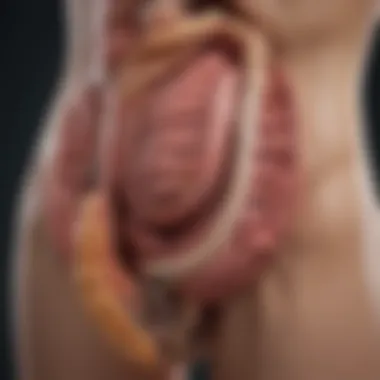Understanding Appendicitis: Signs and Symptoms Explained


Intro
Appendicitis is an acute condition that can significantly impact an individual’s health. It involves inflammation of the appendix, a small organ located at the junction of the small and large intestines. Understanding appendicitis is essential not only for medical professionals but also for the general public. As various symptoms can mimic other illnesses, the quick identification of appendicitis can lead to timely treatment and potentially save lives.
This article comprehensively explores signs, symptoms, diagnostic techniques, and treatment options for appendicitis. The implications of delayed intervention are critical for both patients and healthcare providers. By recognizing the importance of early detection, we aim to equip readers with the knowledge needed to respond effectively to this medical emergency.
Research Context
Background and Rationale
Appendicitis is one of the most common surgical emergencies globally. Studies show that 5 to 10% of the population experiences appendicitis at some point in their lives. Given its prevalence, it is imperative to disseminate accurate information about the condition. The exact cause of appendicitis remains uncertain, often linked to obstruction of the appendix by fecal matter, foreign bodies, or tumors. This blockage can lead to increased pressure, reduced blood flow, and eventually infection.
The urgency surrounding appendicitis cannot be overstated. If left untreated, a swollen appendix can burst, leading to serious complications such as peritonitis or sepsis. This potential for life-threatening situations underscores the importance of understanding the signs and symptoms. Prompt recognition can facilitate early diagnosis and intervention, which can significantly improve patient outcomes.
Literature Review
Recent literature emphasizes the necessity for continual education on appendicitis for patients and healthcare professionals. A systematic review published in Britannica highlights a range of studies focused on diagnostic tools and treatment protocols. The integration of imaging technologies, such as ultrasound and CT scans, has improved diagnostic accuracy. Additionally, recent advancements in laparoscopic surgery have revolutionized treatment, offering minimally invasive options that result in quicker recovery times.
The evolving nature of appendicitis treatment and diagnosis illustrates the critical need for ongoing research. Current trends show a shift from routine appendectomies to a more conservative approach in select cases, illustrating the complexity of this condition. Further studies delve into patient outcomes, exploring how various factors influence recovery and long-term health.
Methodology
Research Design
To deepen our understanding of appendicitis, this research adopts a multi-faceted approach. A combination of quantitative and qualitative methods provides a well-rounded perspective on the subject. Case studies, clinical trials, and comprehensive literature analysis form the backbone of the research framework.
Data Collection Methods
Data collection involves synthesizing information from peer-reviewed journals, clinical guidelines, and reports from healthcare organizations. Clinical data from hospitals provides insights into patient demographics, diagnostic challenges, and treatment outcomes. Surveys targeted at healthcare professionals help gauge current practices and awareness regarding appendicitis.
Ultimately, this research aims to bridge gaps in understanding appendicitis, making critical information accessible to both professionals and patients. The balance between empirical data and real-world experience can lead to better health outcomes for those facing this common yet serious condition.
Intro to Appendicitis
Appendicitis is a medical condition characterized by inflammation of the appendix, a small pouch attached to the large intestine. Understanding appendicitis is crucial not just for medical professionals but also for individuals seeking to educate themselves about health risks. This section aims to offer an overview of appendicitis, highlighting its definition and the anatomical features associated with the appendix.
Defining Appendicitis
Appendicitis occurs when the appendix becomes blocked, often due to stool, a foreign object, or cancer, leading to inflammation. Symptoms typically begin with mild discomfort and can rapidly escalate to severe abdominal pain if left untreated. Recognizing appendicitis early can prevent complications such as perforation, which poses serious health risks. Therefore, grasping the definition of appendicitis is key in understanding general abdominal pain and related symptoms.
Anatomy of the Appendix
The appendix is a narrow tube, measuring about four inches long, situated in the lower right abdomen. Although once considered a vestigial organ with no significant function, recent research suggests it may play a role in gut flora maintenance and immune function. The anatomy of the appendix includes a lumen, which can become obstructed, resulting in inflammation. Understanding this organ's structure and its location plays a vital role in identifying appendicitis and distinguishing it from other gastrointestinal ailments.
"Understanding the anatomy of the appendix helps in pinpointing the source of abdominal pain, making accurate diagnosis easier."
Knowledge of appendicitis enables timely intervention, potentially saving lives. As we delve deeper into the signs and symptoms, we will explore the significance of recognizing this condition promptly.
Signs of Appendicitis
Understanding the signs of appendicitis is critical for effective diagnosis and timely treatment. Early recognition of symptoms can prevent complications and improve patient outcomes. Appendicitis typically begins with vague discomfort, which can progress quickly. Knowledge of these signs can empower individuals to seek medical intervention before the condition worsens. In addition, medical professionals rely on clear symptom descriptions for accurate diagnosis, making public awareness equally important.
Initial Symptoms
The initial symptoms of appendicitis can be subtle and often mistaken for other conditions. Commonly, patients report an uncomfortable sensation in the abdomen, which tends to focus around the central area but may also radiate to the right lower quadrant. This pain often begins as a mild ache, evolving into a sharper discomfort with movements or pressure. Another frequently noted symptom is a low-grade fever, indicating the body's immune response to infection. While these signs may seem mild, they are crucial indicators of potential appendicitis and should not be ignored.
Progression of Symptoms
As appendicitis develops, symptoms can intensify. The abdominal pain usually becomes more localized, shifting from the umbilical region to the right lower abdomen within hours. Additional symptoms often include nausea and vomiting, as well as changes in bowel habits, such as diarrhea or constipation. Patients may also notice difficulty in appetite or feel excessively fatigued. These progressing symptoms heighten the urgency for medical evaluation, as a delay in treatment can lead to severe consequences, including appendiceal rupture.


Common Indicators
Apart from the initial and progressive symptoms, there are several common indicators that may signal appendicitis. Patients frequently experience an increase in tenderness in the right lower abdomen during physical examination. Rebound tenderness is also notable, where pressing down on the area hurts more when released. Other signs include elevated white blood cell count observed in blood tests, which hints at infection. Recognition of these indicators provides valuable information for healthcare professionals and aids in prompt diagnosis.
"Timely identification of appendicitis symptoms can make a substantial difference in patient outcomes, highlighting the need for awareness and education."
In summary, knowing the signs of appendicitis, including initial and common symptoms, is vital. This awareness facilitates early medical intervention and may prevent serious complications.
Typical Symptoms of Appendicitis
Understanding the typical symptoms of appendicitis is critical for timely intervention. The signs can vary between individuals, but recognizing them can mean the difference between minor discomfort and potentially life-threatening complications. This section highlights the most common symptoms, enabling readers to identify the condition early and seek medical help. It also emphasizes the importance of awareness regarding these symptoms, particularly for students, researchers, and healthcare professionals.
Abdominal Pain and Location
Abdominal pain is often the first noticeable symptom of appendicitis. This pain frequently begins around the navel and gradually shifts to the lower right side of the abdomen, known as McBurney's point. It is essential to note that the nature of this pain can change. Initially, it may feel dull or cramp-like, but as the condition progresses, the pain may become sharper and more intense.
This transition is a crucial indicator of appendicitis. For example, if someone experiences a sudden increase in pain or it becomes localized effectively at the lower right quadrant, it is a strong signal to seek medical attention. The location of the pain is significant due to the physiology of the appendix. Distinguishing this pain from other abdominal issues can alleviate confusion and promote quicker diagnosis.
Nausea and Vomiting
Nausea and vomiting often accompany abdominal pain in appendicitis cases. Patients may report feeling nauseous shortly after the onset of pain. This nausea can come without any prior gastrointestinal disturbance, which makes it a particularly noteworthy symptom. Vomiting in appendicitis is typically non-specific, meaning it does not present with other gastrointestinal symptoms like diarrhea or severe bloating.
The presence of nausea and vomiting suggests irritation within the abdominal cavity—often due to the inflammation of the appendix. For healthcare professionals, understanding that these symptoms can signal appendicitis is vital, as they often mimic other conditions, like gastroenteritis. Effective communication of these symptoms to clinicians can expedite diagnosis and treatment.
Loss of Appetite
Loss of appetite may seem trivial but is another common symptom of appendicitis. Affected individuals often find it difficult to eat, feeling unusually full or disinterested in food. This symptom can occur early during the illness, often just before the onset of more severe abdominal pain. The loss of appetite is generally due to the body's response to inflammation, as the gastrointestinal system begins reacting to the distress.
In summary, a combination of abdominal pain, nausea, and loss of appetite can serve as significant red flags for appendicitis. Recognizing these typical symptoms is vital for ensuring prompt diagnosis and intervention. Every reader, whether they are students or professionals, should understand how these signs relate to appendicitis. This awareness can lead to better health outcomes through early medical intervention.
Differential Diagnosis
Differential diagnosis plays a crucial role in the evaluation of appendicitis. This process involves distinguishing appendicitis from other medical conditions that can present similar symptoms. Accurate diagnosis is essential not only for effective treatment but also to avoid unnecessary procedures that could result from misdiagnosis.
When a patient presents with abdominal pain, the healthcare provider must consider various conditions that may mimic appendicitis, such as:
- Gastroenteritis: Often presents with abdominal cramping and diarrhea, which may be confused with appendicitis.
- Ectopic Pregnancy: In females, this can cause severe abdominal pain that could be mistaken for an appendicitis attack.
- Diverticulitis: Characterized by inflammation of the diverticula in the colon that can produce similar symptoms, especially in the lower left abdomen.
- Pancreatitis: Inflammation of the pancreas can also lead to significant abdominal pain and nausea.
Recognizing these conditions is important as treatment varies significantly. An incorrect diagnosis can delay necessary interventions, leading to complications. Therefore, using thorough clinical assessment and diagnostic tools is paramount.
Conditions Mimicking Appendicitis
Appendicitis symptoms can overlap with various other conditions, making an accurate diagnosis a challenge. Identifying these differentiators is vital to ensure proper patient management. Here are a few conditions that often mimic appendicitis:
Gastroenteritis
This infection leads to inflammation of the stomach and intestines, causing nausea, vomiting, and diarrhea. Sometimes, abdominal pain and tenderness can resemble appendicitis.
Ectopic Pregnancy
A life-threatening condition that occurs when a fertilized egg implants outside the uterus. This often manifests as abdominal pain and requires immediate medical attention.
Diverticulitis
This condition arises from inflammation or infection of diverticula in the colon. Symptoms can include abdominal pain, usually in the lower left quadrant, resembling appendicitis.
Pancreatitis
Pancreatitis typically causes severe, persistent abdominal pain. The discomfort can radiate to the back, which can lead to confusion with appendicitis symptoms.


Importance of Accurate Diagnosis
Accurate diagnosis of appendicitis is critical for several reasons. First and foremost, it influences treatment decisions, including whether surgical intervention is necessary. The stakes are high because a delay in managing appendicitis may lead to severe complications such as perforation or abscess formation.
Furthermore, beyond appendicitis, an accurate diagnosis can prevent mismanagement of alternative conditions. For instance, treating ectopic pregnancy or diverticulitis incorrectly can have disastrous consequences.
It is essential for healthcare professionals to employ a combination of physical examination findings, imaging techniques such as ultrasound and CT scans, and laboratory results to confirm appendicitis effectively. This not only improves patient outcomes but also enhances overall healthcare efficiency.
In summary, differential diagnosis is a cornerstone of appendicitis evaluation, ensuring that patients receive the right treatment for their specific condition.
Diagnostic Procedures
Diagnostic procedures play a vital role in the identification and management of appendicitis. Timely and accurate diagnosis can minimize the risk of complications, which can arise if the condition is left untreated. These procedures encompass physical examinations, imaging techniques, and laboratory tests. A comprehensive approach helps clinicians confirm the diagnosis and tailor treatment options effectively.
Physical Examination
In the context of diagnosing appendicitis, a physical examination is a foundational step. Healthcare professionals typically assess abdominal tenderness, especially in the lower right quadrant, where the appendix is located. Additionally, they check for signs of rebound tenderness, which may indicate inflammation. By carefully palpating the abdomen, a clinician can obtain valuable information regarding the patient's condition. However, a physical examination alone may not be definitive, necessitating further diagnostic measures.
Imaging Techniques
Imaging techniques are crucial in confirming a diagnosis of appendicitis. They provide visual insight into the abdomen, allowing medical professionals to assess the appendix and surrounding structures accurately. The most common imaging techniques include:
Ultrasound
Ultrasound serves as a non-invasive imaging method that is often the first choice in suspected appendicitis cases, especially in children and pregnant women. Its key characteristic is the use of sound waves to create images of internal organs. The main advantage of ultrasound lies in its ability to avoid radiation exposure, making it particularly beneficial for vulnerable populations. Limitations may include operator dependency and difficulty visualizing the appendix in some patients.
CT Scan
A CT scan is another prevalent imaging technique used to diagnose appendicitis. It provides detailed cross-sectional images of the body, enhancing the accuracy of diagnosis. The key advantage of a CT scan is its ability to visualize not only the appendix but also the surrounding structures and any potential complications. However, its use involves exposure to radiation, raising concerns about safety in certain patient demographics. Despite this, the CT scan remains a commonly utilized and effective diagnostic tool in clinical practice.
MRI
Magnetic Resonance Imaging (MRI) is less commonly used but can be beneficial in specific cases, particularly in pregnant women. Its key characteristic is the utilization of magnetic fields and radio waves, avoiding radiation exposure. MRI can provide detailed images of the abdominal organs, assisting in diagnosis. However, its limited availability, longer scan times, and expense are significant drawbacks, making it a secondary option for appendicitis diagnosis in many healthcare settings.
Laboratory Tests
Laboratory tests complement imaging and physical examination in the diagnostic process. Blood tests, including a complete blood count (CBC), can reveal elevated white blood cell counts, indicating infection. A urinalysis may also be performed to exclude urinary tract infections, which can present with similar symptoms. These tests, when combined with imaging techniques, enhance the accuracy of diagnosing appendicitis and guide treatment decisions.
Treatment Options
In the landscape of appendicitis management, treatment options play a crucial role. Proper intervention is vital not just for immediate relief but also for preventing severe complications. Understanding the available treatments helps both patients and healthcare providers to make informed decisions based on individual cases.
Surgical Intervention
Surgical intervention is often the first-line treatment for appendicitis. The typical procedure performed is an appendectomy, which involves the removal of the inflamed appendix. There are two main surgical approaches: open surgery and laparoscopic surgery.
- Open appendectomy involves a larger incision, allowing the surgeon direct access to the appendix. This method may be necessary in complicated cases where there is an abscess or other factors impeding access.
- Laparoscopic appendectomy uses small incisions and a camera, making it less invasive. Patients often benefit from shorter recovery times and reduced post-operative pain with this approach.
Benefits of surgical intervention include:
- Immediate resolution of the issue, as removal of the appendix eliminates the cause of pain and potential complications.
- Prevention of complications such as perforation or peritonitis, which can arise if appendicitis is left untreated.
The consideration of surgery includes assessing the patient's overall health and any underlying conditions that may complicate the procedure. While surgery is typically straightforward, it carries inherent risks, such as bleeding or infection, which must also be factored into the decision-making process.
Antibiotic Therapy
Antibiotic therapy has gained attention as a non-surgical approach for certain cases of appendicitis. This treatment involves administering broad-spectrum antibiotics to combat infection and inflammation without immediate surgical intervention.
In specific instances, especially when appendicitis is diagnosed early and the condition is uncomplicated, antibiotics might be the only required treatment.


Key considerations include:
- Effectiveness: Studies suggest that antibiotic therapy may resolve appendicitis symptoms in a notable proportion of patients. Some studies report success rates of 60-80% for treating uncomplicated appendicitis without surgery.
- Monitoring: Patients under antibiotic treatment require careful monitoring to ensure that the condition does not worsen. If symptoms persist or worsen, surgery may still be necessary.
Antibiotic therapy may involve:
- Single-dose therapy: Administering antibiotics at the time of diagnosis.
- Oral antibiotics: After an initial intravenous course in a hospital setting, transitioning to oral medications may be effective.
In summary, both surgical intervention and antibiotic therapy are crucial treatment options for appendicitis, each with distinct advantages, risks, and considerations. The choice between them should be based on clinical evaluation and patient-specific factors, ensuring the best possible outcome for the patient.
Postoperative Care
Postoperative care is essential in ensuring that patients recover from appendicitis surgery effectively. This phase involves multiple components that are crucial for promoting healing and preventing complications. Being informed about postoperative care can significantly enhance recovery outcomes, and it also provides patients with a sense of reassurance during their healing journey.
Recovery Process
The recovery process after appendicitis surgery, typically an appendectomy, involves close monitoring by healthcare professionals. On the first day after the surgery, patients often rest and are observed for any signs of complications. Pain management is a priority during this stage. Medications may be prescribed to alleviate discomfort.
As days progress, patients are encouraged to gradually increase physical activity. Moving around prevents the risk of blood clots and aids digestion, which can be sluggish after surgery. Generally, patients might begin with short walks around the hospital ward. Food intake usually resumes with clear liquids, progressing to solid foods as tolerated.
A key aspect of the recovery process is hydration. Adequate fluid intake facilitates healing and prevents constipation, a common issue post-surgery. Regular follow-up visits with the surgical team are important to assess the recovery progress. It is critical to adhere to all post-surgical instructions provided by healthcare professionals to ensure a smooth recovery.
Adequate postoperative care directly influences long-term physical health and overall well-being.
Potential Complications
Despite the generally straightforward nature of appendicitis surgery, potential complications can arise. Awareness of these risks is vital for patients and caregivers alike. Some potential complications to monitor include:
- Infection: This is a significant concern following any surgical procedure. Signs of infection may manifest as fever, increased pain, or drainage from the surgical site.
- Abdominal Abscess: Accumulation of pus in the abdominal cavity may require further medical intervention, such as drainage.
- Bowel Obstruction: Scar tissue formation can lead to a narrowing of the intestines. This could result in nausea, vomiting, and abdominal pain.
- Delayed Healing: Factors such as pre-existing health conditions or poor nutrition can slow down the healing process.
Monitoring symptoms closely and following up with healthcare providers if any concerning signs occur can mitigate these risks. Maintaining open communication with the surgical team is crucial for addressing any complications that may arise during recovery.
Long-Term Implications
Understanding the long-term implications of appendicitis is crucial for both patients and healthcare professionals. After undergoing surgery or treatment, individuals may face various risks and considerations. Recognizing these factors can lead to better health outcomes and informed decision-making.
Recurring Appendicitis Risks
One of the significant concerns for those who have experienced appendicitis is the risk of recurrence. Although surgical removal of the appendix, known as an appendectomy, is generally effective in preventing future episodes, some individuals may still report symptoms similar to appendicitis. This can be especially true if the initial diagnosis was incorrect or if remnants of the appendix were left behind during surgery. Regular follow-up care is often recommended to monitor any new or recurring symptoms.
Additionally, age and overall health play pivotal roles. Younger patients, particularly children, may see different recurrence patterns compared to adults. Those who are overweight or have underlying health issues may also face a greater risk.
Effects on Digestive Health
The impact of appendicitis and subsequent treatments on digestive health can vary widely. There are individuals who experience no long-term effects, while others may experience significant changes in their digestive system. For example, some studies suggest an increased risk of gastrointestinal issues such as irritable bowel syndrome (IBS) or alterations in bowel habits post-appendectomy.
The absence of the appendix, a small organ that is often regarded as having limited function, does not typically affect digestion significantly. However, its removal can alter the balance of gut flora. This can lead to changes in how the body processes certain foods. Some patients report increased sensitivity to certain foods or a general decrease in digestive efficiency. It is essential for these individuals to monitor their digestive health and seek dietary advice if they notice significant changes.
The importance of ongoing medical support and dietary management cannot be overstated.
In summary, understanding the long-term implications of appendicitis is essential. Individuals should remain vigilant about their health and consult healthcare providers about any unusual symptoms or digestive issues.
The End
The conclusion section serves a crucial role in summarizing the core insights presented throughout the article. It encapsulates the key elements surrounding appendicitis, underscoring the necessity of early diagnosis and treatment. By reflecting on the signs, symptoms, diagnostic approaches, and potential complications, this section provides the reader with a consolidated understanding that is vital for informed decision-making regarding health.
Summary of Key Points
In reviewing the essential aspects of appendicitis, several points emerge as critical:
- Appendicitis manifests through specific signs such as abdominal pain, nausea, and loss of appetite.
- Differential diagnosis is essential to distinguish appendicitis from other conditions with similar symptoms.
- Diagnostic procedures, including imaging techniques like CT scans or ultrasounds, are vital for accurate assessment.
- Treatment often necessitates surgical intervention, which carries certain risks, underscoring the importance of postoperative care.
- Awareness of long-term implications, such as the potential for recurring episodes or digestive health effects, is essential.
The recognition of these key points enhances the reader's understanding, serving not only individuals experiencing symptoms but also healthcare professionals involved in patient care.
Future Research Directions
As medical knowledge evolves, several promising areas warrant further investigation:
- Longitudinal Studies: Research examining long-term outcomes post-appendectomy could illuminate patterns regarding recurrence and digestive health.
- Alternative Treatments: Exploring non-surgical treatment options and their efficacy can present newer approaches in managing appendicitis.
- Preventive Strategies: Studying preventive measures may help identify ways to reduce appendicitis occurrence, which remains a common surgical emergency.
Future research holds the potential to refine diagnostic accuracy, improve treatment protocols, and ultimately enhance patient outcomes. With the aim of advancing our understanding, continual exploration in these areas is paramount.



